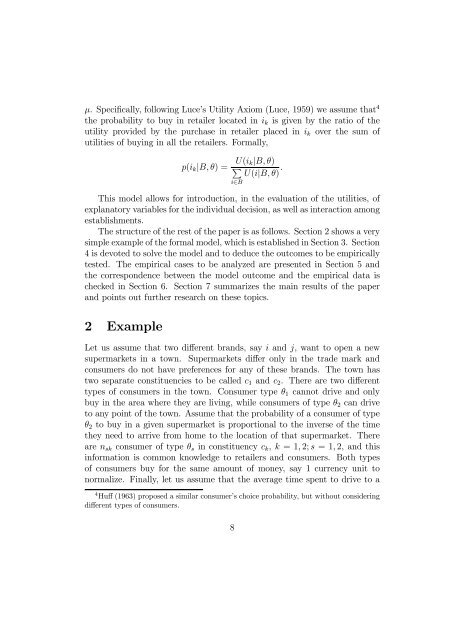Download PDF - Ivie
Create successful ePaper yourself
Turn your PDF publications into a flip-book with our unique Google optimized e-Paper software.
µ. Specifically, following Luce’s Utility Axiom (Luce, 1959) we assume that 4<br />
the probability to buy in retailer located in i k is given by the ratio of the<br />
utility provided by the purchase in retailer placed in i k over the sum of<br />
utilities of buying in all the retailers. Formally,<br />
p(i k |B,θ) =<br />
<br />
U(i k|B,θ)<br />
U(i|B,θ) .<br />
i∈B<br />
This model allows for introduction, in the evaluation of the utilities, of<br />
explanatory variables for the individual decision, as well as interaction among<br />
establishments.<br />
The structure of the rest of the paper is as follows. Section 2 shows a very<br />
simple example of the formal model, which is established in Section 3. Section<br />
4 is devoted to solve the model and to deduce the outcomes to be empirically<br />
tested. The empirical cases to be analyzed are presented in Section 5 and<br />
the correspondence between the model outcome and the empirical data is<br />
checked in Section 6. Section 7 summarizes the main results of the paper<br />
and points out further research on these topics.<br />
2 Example<br />
Let us assume that two different brands, say i and j, wanttoopenanew<br />
supermarkets in a town. Supermarkets differ only in the trade mark and<br />
consumers do not have preferences for any of these brands. The town has<br />
two separate constituencies to be called c 1 and c 2 . There are two different<br />
types of consumers in the town. Consumer type θ 1 cannot drive and only<br />
buy in the area where they are living, while consumers of type θ 2 can drive<br />
to any point of the town. Assume that the probability of a consumer of type<br />
θ 2 to buy in a given supermarket is proportional to the inverse of the time<br />
they need to arrive from home to the location of that supermarket. There<br />
are n sk consumer of type θ s in constituency c k , k =1, 2; s =1, 2, and this<br />
information is common knowledge to retailers and consumers. Both types<br />
of consumers buy for the same amount of money, say 1 currency unit to<br />
normalize. Finally, let us assume that the average time spent to drive to a<br />
4 Huff (1963) proposed a similar consumer’s choice probability, but without considering<br />
different types of consumers.<br />
8
















